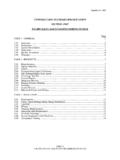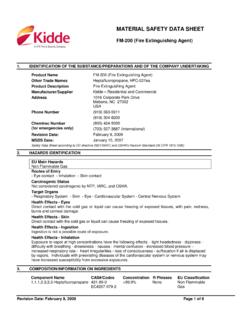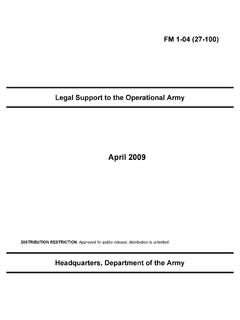Transcription of SOA/CAS Exam FM Sample Questions - saab
1 11/08/04 2 SOCIETY OF ACTUARIES/CASUALTY ACTUARIAL SOCIETY EXAM FM FINANCIAL MATHEMATICS EXAM FM Sample Questions Copyright 2005 by the Society of Actuaries and the Casualty Actuarial Society Some of the Questions in this study note are taken from past SOA/CAS examinations. FM-09-05 PRINTED IN 11/08/04 3 These Questions are representative of the types of Questions that might be asked of candidates sitting for the new examination on Financial Mathematics (2/FM).
2 These Questions are intended to represent the depth of understanding required of candidates. The distribution of Questions by topic is not intended to represent the distribution of Questions on future exams. 11/08/04 41. Bruce deposits 100 into a bank account. His account is credited interest at a nominal rate of interest of 4% convertible semiannually. At the same time, Peter deposits 100 into a separate account. Peter s account is credited interest at a force of interest of . After years, the value of each account is the same. Calculate.
3 (A) (B) (C) (D) (E) 11/08/04 52. Kathryn deposits 100 into an account at the beginning of each 4-year period for 40 years. The account credits interest at an annual effective interest rate of i. The accumulated amount in the account at the end of 40 years is X, which is 5 times the accumulated amount in the account at the end of 20 years. Calculate X. (A) 4695 (B) 5070 (C) 5445 (D) 5820 (E) 6195 11/08/04 63.
4 Eric deposits 100 into a savings account at time 0, which pays interest at a nominal rate of i, compounded semiannually. Mike deposits 200 into a different savings account at time 0, which pays simple interest at an annual rate of i. Eric and Mike earn the same amount of interest during the last 6 months of the 8th year. Calculate i. (A) (B) (C) (D) (E) 11/08/04 74.
5 John borrows 10,000 for 10 years at an annual effective interest rate of 10%. He can repay this loan using the amortization method with payments of 1, at the end of each year. Instead, John repays the 10,000 using a sinking fund that pays an annual effective interest rate of 14%. The deposits to the sinking fund are equal to 1, minus the interest on the loan and are made at the end of each year for 10 years. Determine the balance in the sinking fund immediately after repayment of the loan. (A) 2,130 (B) 2,180 (C) 2,230 (D) 2,300 (E) 2,370 11/08/04 85.
6 An association had a fund balance of 75 on January 1 and 60 on December 31. At the end of every month during the year, the association deposited 10 from membership fees. There were withdrawals of 5 on February 28, 25 on June 30, 80 on October 15, and 35 on October 31. Calculate the dollar-weighted (money-weighted) rate of return for the year. (A) (B) (C) (D) (E) 11/08/04 96. A perpetuity costs and makes annual payments at the end of the year.
7 The perpetuity pays 1 at the end of year 2, 2 at the end of year 3, .., n at the end of year (n+1). After year (n+1), the payments remain constant at n. The annual effective interest rate is Calculate n. (A) 17 (B) 18 (C) 19 (D) 20 (E) 21 11/08/04 107. 1000 is deposited into Fund X, which earns an annual effective rate of 6%. At the end of each year, the interest earned plus an additional 100 is withdrawn from the fund.
8 At the end of the tenth year, the fund is depleted. The annual withdrawals of interest and principal are deposited into Fund Y, which earns an annual effective rate of 9%. Determine the accumulated value of Fund Y at the end of year 10. (A) 1519 (B) 1819 (C) 2085 (D) 2273 (E) 2431 11/08/04 118. You are given the following table of interest rates: Calendar Year of Original Investment Investment Year Rates (in %) Portfolio Rates (in %) y i1y i2y i3y i4y i5y iy+5 1992 1993 1994 1995 1996 1997 1998 1999 2000 2001 A person deposits 1000 on January 1, 1997.
9 Let the following be the accumulated value of the 1000 on January 1, 2000: P: under the investment year method Q: under the portfolio yield method R: where the balance is withdrawn at the end of every year and is reinvested at the new money rate Determine the ranking of P, Q, and R. (A) PQR>> (B) PRQ>> (C) QPR>> (D) RPQ>> (E) RQP>> 11/08/04 129. A 20-year loan of 1000 is repaid with payments at the end of each year. Each of the first ten payments equals 150% of the amount of interest due.
10 Each of the last ten payments is X. The lender charges interest at an annual effective rate of 10%. Calculate X. (A) 32 (B) 57 (C) 70 (D) 97 (E) 117 11/08/04 1310. A 10,000 par value 10-year bond with 8% annual coupons is bought at a premium to yield an annual effective rate of 6%. Calculate the interest portion of the 7th coupon. (A) 632 (B) 642 (C) 651 (D) 660 (E) 667 11/08/04 1411.







